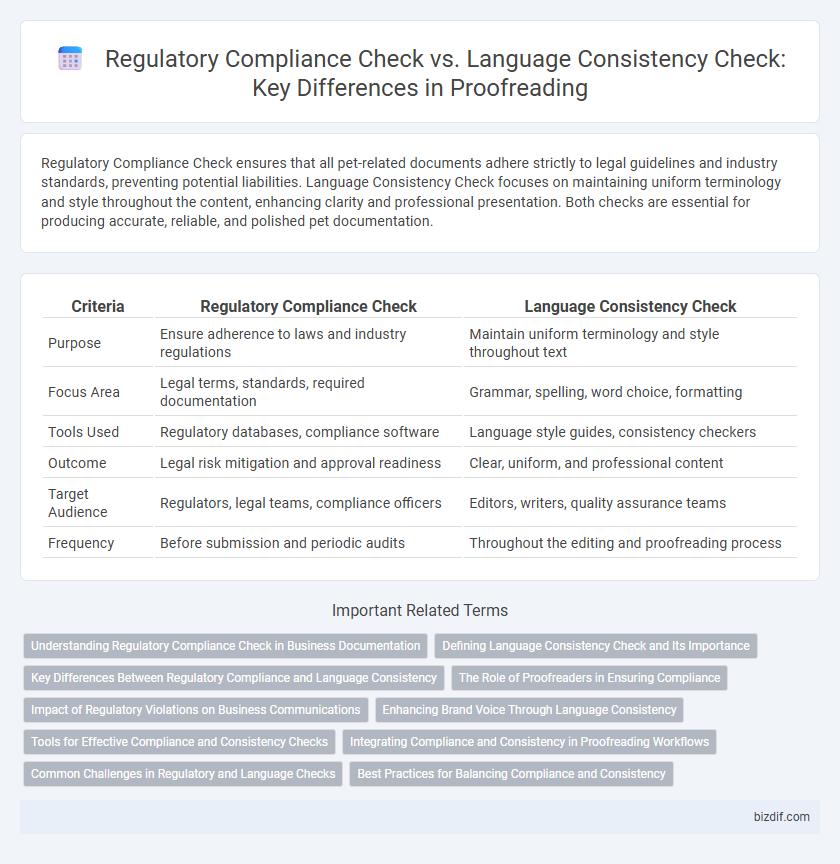Regulatory Compliance Check ensures that all pet-related documents adhere strictly to legal guidelines and industry standards, preventing potential liabilities. Language Consistency Check focuses on maintaining uniform terminology and style throughout the content, enhancing clarity and professional presentation. Both checks are essential for producing accurate, reliable, and polished pet documentation.
Table of Comparison
| Criteria | Regulatory Compliance Check | Language Consistency Check |
|---|---|---|
| Purpose | Ensure adherence to laws and industry regulations | Maintain uniform terminology and style throughout text |
| Focus Area | Legal terms, standards, required documentation | Grammar, spelling, word choice, formatting |
| Tools Used | Regulatory databases, compliance software | Language style guides, consistency checkers |
| Outcome | Legal risk mitigation and approval readiness | Clear, uniform, and professional content |
| Target Audience | Regulators, legal teams, compliance officers | Editors, writers, quality assurance teams |
| Frequency | Before submission and periodic audits | Throughout the editing and proofreading process |
Understanding Regulatory Compliance Check in Business Documentation
Regulatory Compliance Check in business documentation ensures that all content adheres to industry-specific laws, standards, and guidelines, minimizing legal risks and preventing costly penalties. This process involves verifying terminology accuracy, mandatory disclosures, and adherence to formatting requirements as stipulated by regulatory bodies such as the FDA, SEC, or GDPR authorities. Unlike Language Consistency Check, which focuses on uniform style and tone, Regulatory Compliance Check emphasizes legal precision and document validity within the regulatory framework.
Defining Language Consistency Check and Its Importance
Language Consistency Check ensures uniform terminology, style, and tone across a document, preventing misunderstandings and enhancing readability. Maintaining consistent language is critical for regulatory compliance as it supports accurate interpretation of rules and reduces legal risks. This process strengthens the overall quality of communication, fostering trust and clarity in professional and official texts.
Key Differences Between Regulatory Compliance and Language Consistency
Regulatory compliance checks focus on ensuring that documents adhere to specific industry laws, standards, and guidelines, often involving legal terminology and mandatory disclosures. Language consistency checks prioritize uniformity in style, tone, terminology, and grammar throughout the document to maintain clarity and professionalism. While regulatory compliance is driven by external requirements, language consistency is an internal quality standard aimed at improving readability and coherence.
The Role of Proofreaders in Ensuring Compliance
Proofreaders play a critical role in ensuring regulatory compliance by meticulously verifying that documents adhere to industry-specific guidelines, legal standards, and company policies, reducing the risk of non-compliance penalties. Language consistency checks complement this by maintaining uniform terminology, style, and tone throughout the text, which enhances clarity and professional credibility. Combining both checks, proofreaders help organizations produce accurate and legally sound documents that meet regulatory requirements and uphold brand integrity.
Impact of Regulatory Violations on Business Communications
Regulatory compliance checks ensure that business communications adhere to industry-specific laws and standards, preventing costly fines and legal repercussions. Language consistency checks maintain uniform terminology and style but do not address legal requirements, which are critical in regulated sectors like healthcare, finance, and pharmaceuticals. Failure to comply with regulatory standards in business communications can result in damaged reputation, loss of client trust, and severe financial penalties.
Enhancing Brand Voice Through Language Consistency
Language consistency checks ensure uniform terminology, tone, and style across all corporate communications, reinforcing a strong and recognizable brand voice. Regulatory compliance checks focus on adhering to industry standards and legal requirements, which, while crucial, do not directly influence the brand's linguistic identity. Enhancing brand voice through language consistency fosters trust and professionalism, creating a cohesive customer experience that supports brand recognition and loyalty.
Tools for Effective Compliance and Consistency Checks
Regulatory compliance checks utilize specialized software such as SmartCompliance and ComplyGuard to scan documents for adherence to industry-specific legal standards, ensuring all mandatory clauses and terminologies are included. Language consistency checks employ tools like Grammarly Business and PerfectIt, which focus on uniform style, grammar, and terminology usage throughout the text to maintain brand voice and clarity. Integrating these tools within a document management system streamlines workflow, reduces human error, and accelerates the review process for comprehensive content validation.
Integrating Compliance and Consistency in Proofreading Workflows
Integrating regulatory compliance checks with language consistency in proofreading workflows ensures documents meet legal standards while maintaining clear communication. Employing advanced software tools that detect regulatory terms alongside stylistic inconsistencies enhances accuracy and reduces risk. Streamlined processes incorporating both checks improve overall document quality and compliance adherence in industries like pharmaceuticals, finance, and legal services.
Common Challenges in Regulatory and Language Checks
Regulatory compliance checks often face challenges in accurately interpreting complex, industry-specific legal requirements, while language consistency checks struggle with maintaining uniform tone, style, and terminology throughout large documents. Both processes require meticulous attention to detail to avoid errors that could lead to legal risks or miscommunication. Ensuring alignment between regulatory terminology and linguistic clarity is crucial for producing compliant and coherent documents.
Best Practices for Balancing Compliance and Consistency
Regulatory compliance checks ensure that content adheres to legal standards and industry regulations by verifying terminology, claims, and required disclosures. Language consistency checks focus on maintaining uniform style, tone, and vocabulary across documents to enhance readability and brand identity. Best practices involve integrating both checks within the proofreading process using specialized software tools and expert reviewers to balance strict compliance demands with seamless, coherent language.
Regulatory Compliance Check vs Language Consistency Check Infographic

 bizdif.com
bizdif.com